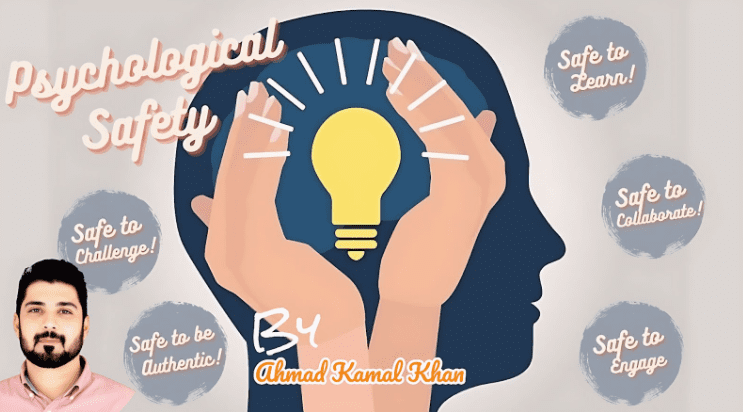Psychological Safety Is Retail’s Secret Weapon For Innovation

Checkout Line Lesson
On a busy Friday evening in a high-street supermarket, a cashier noticed that the new self-checkout system had been freezing when customers used vouchers. She has hesitated to report it, where her manager had once brushed off concerns as “complaining”, so she kept quiet. Moreover, hundreds of customers had queued angrily by Sunday, where staff morale had plummeted, and the head office had been scrambling to fix the disaster that could have been avoided with one honest conversation. This story mainly considers a reality across the retail sector, where innovation does not occur daily due to bad technology or a weak strategy. However, it fails due to employees not feeling safe enough to speak up.
What is Psychological Safety, and Why Should Retail Care?
The conceptualization of psychological safety, mainly championed by authors Klajkó et al. (2020), refers to the workplace climate where people feel free to take risks, share bold ideas, and admit mistakes without any kind of fear of ridicule or punishment. Moreover, studies reflected that the best-performing groups have not been the smartest, but the safest. And this has not been just a theory. In the retail environment, where margins have been thin, customer requirements shift daily, and competition has been intense, psychological safety has been the lifeline. Lack of this mainly leads to frontline insights staying buried, small problems snowball, and employees disengage.
Moreover, psychological safety involves a hidden competitive advantage phenomenon in the retail sector. In addition to this, shop floor employees also feel confident to raise issues when they identify inefficiencies before they harm the business.
For instance, workers mainly notice stock theft patterns, broken procedures, and mislabelling of promotion, which lack technological advancements. In the retail sector, customer loyalty changes overnight, enabling an ability to quickly understand from staff insights to ensure scalability. Retailers that foster safety for employees’ protection and well-being unlock grassroots innovation. Therefore, a psychologically safe environment has not been a luxury, yet it is a survival phenomenon for modern retail.
The Leadership Blind Spot
Many managers still consider silence as harmony. A quiet team may look efficient, yet often it’s just suppressed fear and frustration. Recent work by Klajkó et al. (2020) reinforces this point. The research article emphasises that leadership style has been the core driver for the psychologically safe feeling among team members.
Leadership that has been approachable and inclusive delivers a climate where people share ideas inclusively. Moreover, those who avoid such input, even unintentionally, stifle dialogue – and with it, innovation. For HR professionals and store managers, the lesson has been simple: when staff do not speak up, it’s rarely due to they have nothing to say. It’s because they do not believe it’s safe to say it.
The conceptualization of blind spots has been especially damaging in retail, where frontline staff have been closest to customers yet feel most ignored. Furthermore, a manager who insists “eventing is fine” may overlook critical signs of warning, including staff burnout, long waiting times, and repetition in stock challenges.
Moreover, the environment of brushing aside feedback creates silent employees, along with normalizing inefficiency. Leaders who consider avoiding the management of concern unintentionally set the tone that speaking up has zero value. Moreover, this mainly creates disengagement, high turnover, and loss of trust. Therefore, recognition of silence as a red flag rather than a sign of stability has been the first conservative consideration towards transition.
Why Safety Helps in Improving Innovation in Retail
Problems Surface Early in a fast-moving shop floor, small glitches, such as mispriced items or a stock system hiccup, can spiral into expensive disaster, where safe teams raise red flags before they explode. Customer Benefit Directly, when staff feel safe, they consider sharing ideas to reshape service. Furthermore, this smarter way helps in handling complaints or a creative foundation to delight shoppers, and psychological safety turns staff inputs into customer engagement.
The turnover problem of retail has been legendary. Here, Klajkó et al. (2020) highlighted the requirement of safe climates to build social capital, including trust and collaboration, to make people want to stay. Consideration of respect in the workplace helps in creating loyalty and saves money.
The phenomenon of innovation in the retail sector lacks flashy technology or redesign of the stock, which is mainly driven by employees suggesting simple improvements. Moreover, a cashier incorporates a recommendation regarding a new queuing application, or a stock assistant could initiate smarter replenishment routines. In addition to this, this idea thrives in a safe workplace, where contributions have been valued regardless of job title.
Furthermore, a reduction in fear of punishment, mainly driven by a feeling of safety, when mistakes arise, encourages experimentation. Teams have been free to try, fail, and learn quickly for innovation rather than those that avoid challenges. Therefore, safety conceptualization of a culture incorporates continuous improvement, which has been required for the long-term competitiveness of the retail sector.
Building a Speak-Up Culture
- So, how do retail leaders focus on moving from theory to practice?
- Model vulnerability has been on the topic. When managers say, “I got that wrong, what do you think?”
- This sets the tone that mistakes have been learning opportunities, not punishment.
- Reward honesty, even when it stings. If an employee considers a failed initiative, thank them. This can be a critique to build a better relationship.
- Design Safe spaces, where simple rituals, such as “idea huddles” before shifting debriefs, asking, “What did not work today?” can normalize open communication.
- In addition to this, training programs on active listening and empathy reinforce the supportive climate for supervisors.
- These aspects have been small, yet they reshape climates and unlock innovation. Retail leaders can also consider embedding psychological safety into daily operations, considering structured initiatives.
- Moreover, anonymous digital recommendation boxes of weekly open-door sessions include multiple platforms for employees to share without fear.
- Additionally, recognition systems can be integrated beyond sales metrics to celebrate honesty, communication, and problem-solving approaches.
- Employees mainly focus on speaking up leads to real transition, including adjustments in schedules, fixed procedures, and policy improvements to begin trusting leadership.
- Therefore, these small conservative actions improve and transform workplaces into ecosystems of trust, dependency, and scalability.
A Story of Success
Consideration of Walmart’s rollout of digital shelf-edge labels in several US markets. In some branches, glitches have affected the procedures, where labels glared under harsh lights or confused shoppers. Here, managers encouraged open discussion, teams flagged problems effectively, and suggested practical fixes.
This consideration of smooth interpretation leads to avoiding customer complaints and saving costly delays. The variation has never been about the technological aspects; it has been about culture. This example reflects the determination of outcomes from culture more than tools themselves. Moreover, dialogues have been encouraged in the workplace, which leads employees to ensure experiments with lighting adjustments, signage placements, and clearer instructions for customers. Therefore, these suggestions have been practical and low-cost, ensuring effectiveness.
Closing the Loop
Back at the supermarket checkout, consideration of the cashier felt safe raising her concern. A quick software patch could have prevented the customer burnout and stressed staff. This reflects the requirement of psychological safety in the retail sector, which is a secret weapon for innovation. The question for the retail leaders has been simple: In your stores, do staff feel safe enough to speak?
Author: Ahmad Kamal Khan




